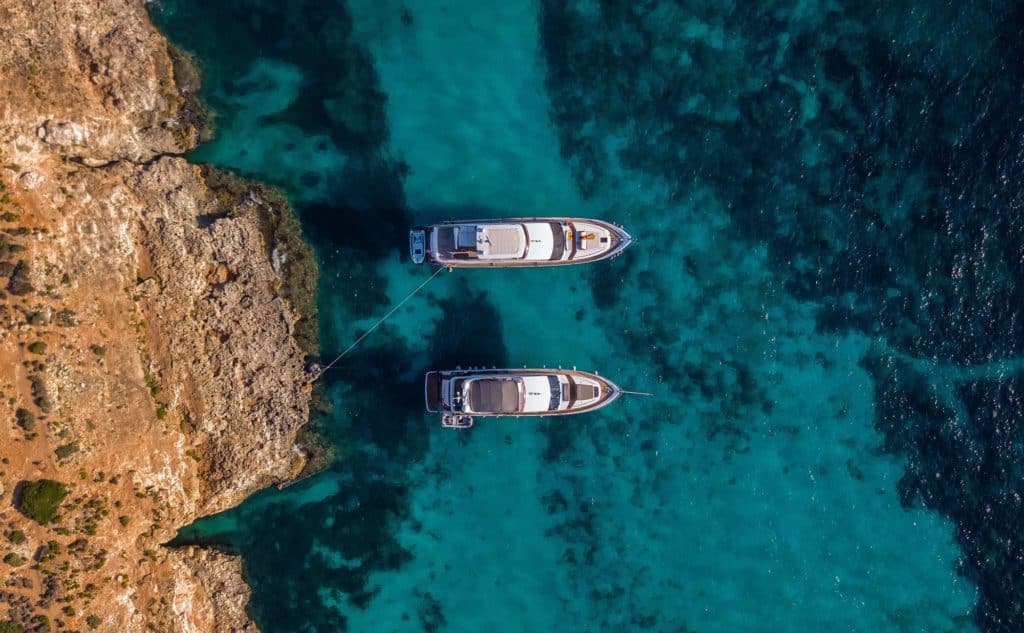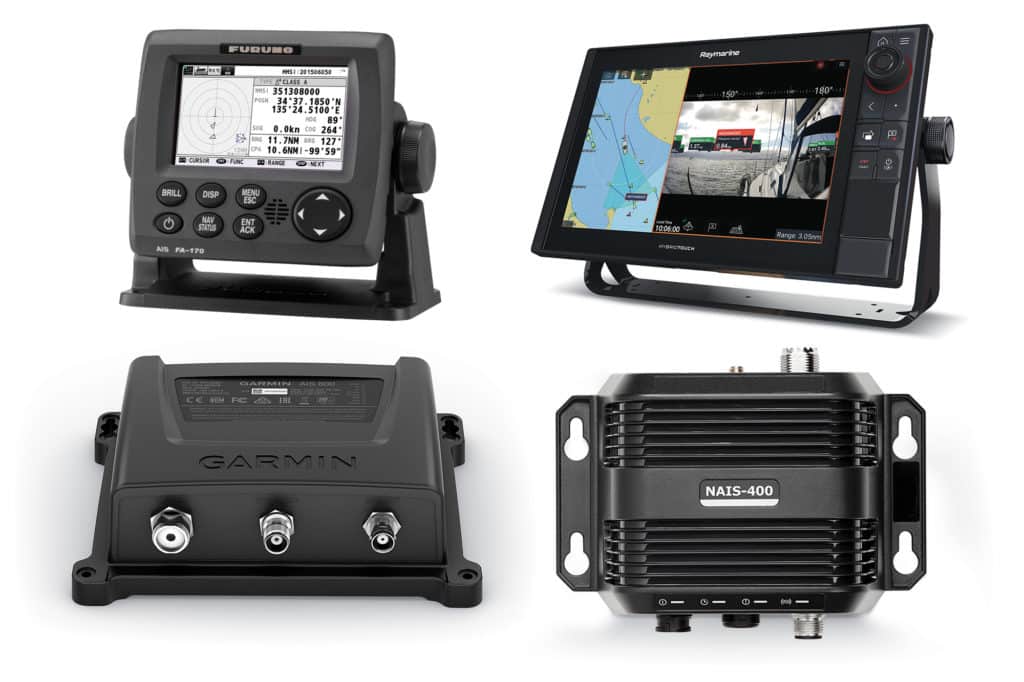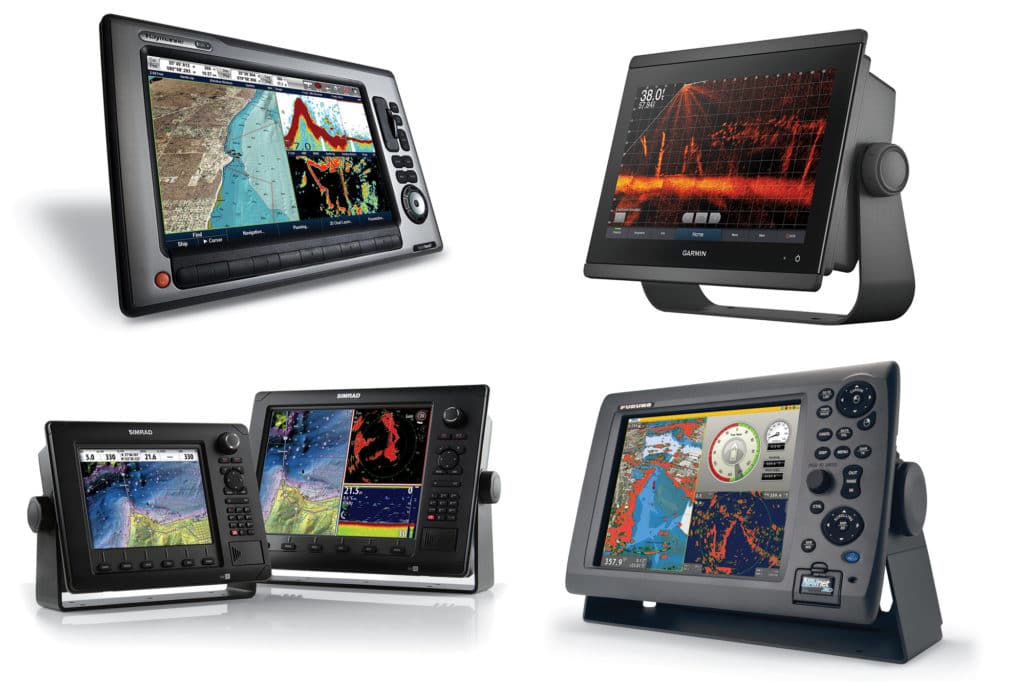
Few technologies have played a greater role in preventing at-sea collisions during the past 18 years than AIS transceivers, which broadcast a vessel’s navigation data—including digital selective calling information and real-time GPS—over VHF radio frequencies. Receiving vessels within VHF range display this information onscreen as icons that can be overlaid atop electronic cartography or a radar display.
Ten years ago, mariners could choose between two kinds of AIS transceivers. Class A transceivers have a dedicated display and broadcast their position information every two to 10 seconds (vessel speed depending) at 12.5 watts using the Self-Organized Time Division Multiple Access scheme. Class B units, which are aimed at recreational users, “politely” broadcast every 30 seconds at 2 watts using the Carrier-Sense Time Division Multiple Access scheme. While the latter is effective in wide-open waters aboard slower-moving vessels such as sailboats or long-range cruisers, Class B/CSTDMA transmissions regularly get trampled by Class A communications, meaning they can go unheard in crowded waters. Moreover, fast-moving Class B targets can outrun their displayed AIS icons, leading to confusion.
Today, Class A AIS is mandated equipment aboard passenger vessels and internationally bound commercial vessels over 300 gross tons, while Class B AIS is largely unregulated.
In 2015, the Federal Communications Commission approved the use of Class B/SOTDMA (“Class B-SO”) transceivers, which broadcast their position information at 5 watts every five, 15 or 30 seconds, depending on vessel speed. “As soon as the regulations for Class B-SO products [were] published, all [manufacturers] started working on them because they’re a great balance of the technical benefits of Class A but much closer to the price point of a Class B,” says Greig Keesing, Simrad’s product manager.
This balance makes Class B-SO a powerful option. “I think Class B-SO should probably be strongly preferred by customers over everything else,” says Eric Kunz, Furuno’s senior product manager. “The extra power and faster transmissions [are] a lot better.”
Others agree. “There’s more reliability,” says David Dunn, Garmin’s director of sales and marketing for marine, about Class B-SO systems. “I could see it becoming a requirement for recreational boaters.”
While regulations have played a big role in the evolution of AIS, so too have hardware and software developments. Ten years ago, “Class B AIS was yet another [downstream] black box, but now it’s a lot smaller,” says Jim McGowan, Raymarine’s Americas marketing manager, adding that first-generation AIS used NMEA 0183 connectivity, whereas today’s AIS uses higher-speed and easier-to-install NMEA 2000 connectors. Additionally, some Class B AIS transceivers now have dedicated monitors.

While faster connectivity and dedicated screens are important developments, “the biggest changes have been on the presentation side,” McGowan adds. “Back then, AIS was a little triangle on an MFD with a vessel’s name, [closest point of approach] and speed. Now, the system is a lot smarter.”
For example, some AIS transceivers scale AIS targets to physically represent their real-world vessels, while some systems display danger zones.
Carl Omundsen, Vesper Marine’s co-founder and chief technical officer, agrees. “Much of the signal processing required to encode and decode the AIS messages can now be defined in software that can replace a large portion of the more traditional hardware-intensive analog implementation,” he says.
Like McGowan, Omundsen points to the recent trend of bundling miniaturized AIS technology into DSC-capable VHF radios—or into Vesper’s revolutionary Cortex safety-and-communications platform—as other game-changers.
“I think [AIS] integration into VHF systems is a natural one. AIS, VHF and DSC tightly integrated into one user experience makes for a powerful communications system,” says Omundsen, adding that he also expects to see greater integration between AIS and MFDs in the future.
Moving forward, all experts agree that AIS is likely to play an increasingly large onboard role, but Kunz cautions that AIS is designed to supplement—not replace—radar.
“AIS only tells you who’s out there with an AIS system, but nothing [about] boats that don’t [carry an AIS transceiver],” he says. Because of this, Kunz strongly recommends using radar to fact-check AIS targets, a task that is especially important if the target is a fast boat fitted with a Class B/CSTDMA transceiver.
Modern MFDs combine the processing power and app-driven, multitouch user interfaces of fast wireless devices with the onscreen pop of modern TVs, and they come bundled in marinized packages that can withstand everything from high-latitude cold to equatorial heat. To accomplish this, MFD manufacturers leverage the far bigger consumer-electronics market for faster processors, more memory and bigger, more eye-pleasing displays.
Multitouch-enabled MFDs are the norm today, but the market was appreciably different in 2010. A decade ago, Simrad’s Keesing says, the company’s high-end MFDs employed rotary dials, hard buttons and alphanumeric keypads to tackle user-interface commands. “[It] came with an 8- or 12-inch color screen, [and] it was the first Simrad MFD with LED backlighting,” he says.
Today, users have the benefit of advances in LCD-screen technology such as in-plane switching, which delivers better off-angle viewing, and optical bonding, which mitigates fogging.
“Everything we make today is optically bonded,” says Garmin’s Dunn, adding that other crucial evolutions include embedding GPS antennas and basic sonars into MFDs, and adding HD video inputs, Ethernet ports and Wi-Fi connectivity. These evolutions matter because Ethernet allows networked MFDs to display sonar or radar feeds on multiple screens (or at multiple helms); HDMI video inputs facilitate higher-definition onscreen imagery; and Wi-Fi connectivity allows users to access an MFD’s navigational information (and sometimes even system controls) from networked wireless devices, use cellular-enabled devices as portals for delivering updates and cloud connectivity, and back up hard-won intellectual property.
“For fishermen, fear of losing their waypoints can be overwhelming,” Dunn says. “But if the system backs itself up, it’s peace of mind.”
Some 2010-generation MFDs offered a touchscreen user interface—however, pinch-to-zoom capabilities didn’t arrive until 2012-13. Today, customers have a choice of MFD interfaces ranging from touch-only to hybridized touchscreens and buttons to hard-button-only options.

While customers naturally gravitate toward cutting-edge features, Furuno’s Kunz points to the underlying operating-system architecture as a significant evolution. “Most manufacturers adopted an Android or Windows platform, so there’s a lot of scalability,” he says, adding that OS familiarity allows manufacturers to create new hardware without expecting customers to study manuals.
As with computers, it’s impossible to discuss MFDs without delving into processing power and speed. Today’s MFDs are “at least three to four times faster and more powerful,” Kunz says.
McGowan agrees, adding that, 10 years ago, Raymarine offered a single-core processor. “Now, we use a quad-core processor with a huge amount of memory,” he says, pointing to miniaturization and better heat-sinking technologies as other important MFD advances. “The architecture is built for speed, so it fills in immediately. There’s no waiting. … It runs circles around [a 2010 MFD] right out of the box.”
Improved horsepower and speed have also allowed manufacturers to get rid of some downstream black boxes in favor of embedded componentry, and to create tighter synergy between MFDs and third-party digital switching systems.
“Ten years ago, large-scale integration didn’t exist,” Kunz says. “It’s allowed us to slowly and steadily build a glass bridge and control the whole boat.”
This improved integration and connectivity is collectively encouraging a push to use the vessel’s MFD to control third-party systems. “Customers are using their MFD to watch Netflix and to connect to other systems—for example, their Seakeeper gyrostabilizers and Lumishore lighting,” McGowan says, adding that MFDs have become “a portal through which we can talk to things.”
Finally, there’s glass. “Nobody ever complains that their MFD is too big,” McGowan says, adding that customers have been amazed as high-end MFDs have steadily expanded to today’s 24-inch monsters.
Dunn agrees. “Most people want the biggest TV that they can fit and afford in their house,” he says, adding that screen-size preferences typically follow customers aboard.
Moving forward, customers can expect greater connectivity between their MFD and onboard systems, more app-based control of onboard systems from afar, and more-refined software and user-interface capabilities. “Today’s technology allows us to get creative and come up with innovative ways to make customers’ boating lives better,” Dunn says, “and we want their time on the water to be as joyful as possible.”









